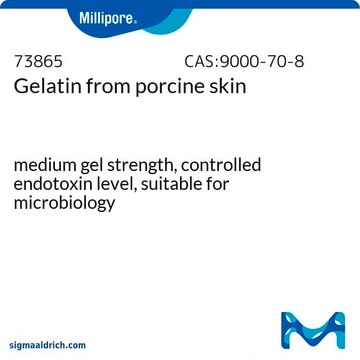48722
Gelatina from porcine skin
medium gel strength, suitable for microbiology
Sinónimos:
Gelatine, hydrolyzed collagen, collagen hydrolysate, gelatine hydrolysate
About This Item
Productos recomendados
biological source
Porcine
Quality Level
sterility
non-sterile
form
powder
quality
medium gel strength
packaging
bottle of 100 g
bottle of 500 g
ign. residue
≤2%
loss
≤15% loss on drying
color
light yellow
pH
4.0-6.0 (25 °C, 67 mg/mL in H2O)
gel strength
165-195 g Bloom (67 mg/ml water)
solubility
H2O: 67 mg/mL at 50 °C, slightly hazy, slightly yellow
anion traces
chloride (Cl-): ≤3000 mg/kg
cation traces
Ca: ≤2000 mg/kg
Cd: ≤5 mg/kg
Co: ≤5 mg/kg
Cr: ≤10 mg/kg
Cu: ≤50 mg/kg
Fe: ≤50 mg/kg
K: ≤500 mg/kg
Mg: ≤500 mg/kg
Mn: ≤5 mg/kg
Na: ≤5000 mg/kg
Ni: ≤5 mg/kg
Pb: ≤5 mg/kg
Zn: ≤10 mg/kg
application(s)
microbiology
¿Está buscando productos similares? Visita Guía de comparación de productos
General description
Gelatin is a heterogeneous mixture of water-soluble proteins of high average molecular masses present in collagen. Proteins are extracted by boiling the relevant skin, tendons, ligaments, bones, etc., in water. Type A gelatin is derived from acid-cured tissue, and Type B from lime-cured tissue.
The Bloom number, determined by the Bloom gelometer, is an indication of the strength of a gel formed from a solution of the known concentration. The Bloom number is proportional to the average molecular mass. Bloom numbers of porcine skin Gelatin vary from 90 to 300 g. This product has a gel strength of 180.
Application
Components
Caution
Preparation Note
Storage Class
11 - Combustible Solids
wgk_germany
nwg
ppe
Eyeshields, Gloves, type N95 (US)
Choose from one of the most recent versions:
¿Ya tiene este producto?
Encuentre la documentación para los productos que ha comprado recientemente en la Biblioteca de documentos.
Los clientes también vieron
Nuestro equipo de científicos tiene experiencia en todas las áreas de investigación: Ciencias de la vida, Ciencia de los materiales, Síntesis química, Cromatografía, Analítica y muchas otras.
Póngase en contacto con el Servicio técnico









